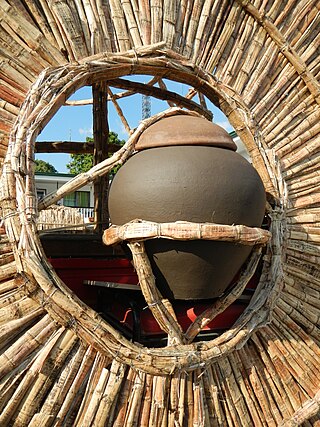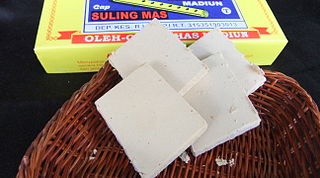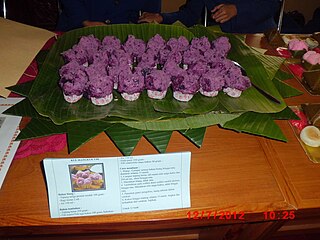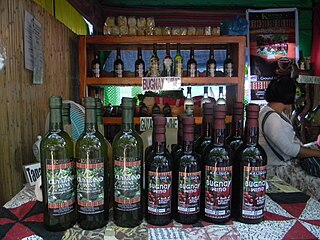
Glutinous rice is a type of rice grown mainly in Southeast and East Asia, and the northeastern regions of South Asia, which has opaque grains, very low amylose content, and is especially sticky when cooked. It is widely consumed across Asia.

Malaysian cuisine consists of cooking traditions and practices found in Malaysia, and reflects the multi-ethnic makeup of its population. The vast majority of Malaysia's population can roughly be divided among three major ethnic groups: Malays, Chinese and Indians. The remainder consists of the indigenous peoples of Sabah and Sarawak in East Malaysia, the Orang Asli of Peninsular Malaysia, the Peranakan and Eurasian creole communities, as well as a significant number of foreign workers and expatriates.

Kuih are bite-sized snack or dessert foods commonly found in Southeast Asia and China. It is a fairly broad term which may include items that would be called cakes, cookies, dumplings, pudding, biscuits, or pastries in English and are usually made from rice or glutinous rice. In China, where the term originates from, kueh or koé (粿) in the Min Nan languages refers to snacks which are typically made from rice but can occasionally be made from other grains such as wheat. The term kuih is widely used in Malaysia, Brunei, and Singapore, kueh is used in Singapore and Indonesia, kue is used in Indonesia only, all three refer to sweet or savoury desserts.

Bibingka commonly refers to a type of baked rice cake from the Philippines that is traditionally cooked in a terracotta oven lined with banana leaves and is usually eaten for breakfast or as merienda especially during the Christmas season. It is also known as bingka in the Visayas and Mindanao islands.

A rice cake may be any kind of food item made from rice that has been shaped, condensed, or otherwise combined into a single object. A wide variety of rice cakes exist in many different cultures in which rice is eaten. Common variations include cakes made with rice flour, those made from ground rice, and those made from whole grains of rice compressed together or combined with some other binding substance.

Kue is an Indonesian bite-sized snack or dessert food. Kue is a fairly broad term in Indonesian to describe a wide variety of snacks including cakes, cookies, fritters, pies, scones, and patisserie. Kue are made from a variety of ingredients in various forms; some are steamed, fried or baked. They are popular snacks in Indonesia, which has the largest variety of kue. Because of the countries' historical colonial ties, Koeé (kue) is also popular in the Netherlands.

Rice flour is a form of flour made from finely milled rice. It is distinct from rice starch, which is usually produced by steeping rice in lye. Rice flour is a common substitute for wheat flour. It is also used as a thickening agent in recipes that are refrigerated or frozen since it inhibits liquid separation.

Basi is a native Ilocano fermented alcoholic beverage or wine made with sugarcane juice, particularly those produced in Northern Luzon particularly in Ilocos Region. This wine is processed in "burnay" or "tapayan".

Brem is traditional fermented food or fermented beverage from Indonesia. There are two types of brem, brem cake (solid) that is usually eaten as snack from Madiun and Wonogiri, and brem beverage (liquid) made of rice wine from Bali and Nusa Tenggara, but mostly known from Bali. Brem first appeared in Java around the year 1000, based on investigations regarding old Javanese inscriptions and literature.

Rượu nếp is a pudding or drink from northern Vietnam.

Puto is a Filipino steamed rice cake, traditionally made from slightly fermented rice dough (galapong). It is eaten as is or as an accompaniment to a number of savoury dishes. Puto is also an umbrella term for various kinds of indigenous steamed cakes, including those made without rice. It is a sub-type of kakanin.

Jiuniang is a sweet, soup- or pudding-like dish in Chinese cuisine. It is also known as sweet wine or sweet rice wine. It consists of a mixture of partially digested rice grains floating in a sweet saccharified liquid, with small amounts of alcohol (1.5–2%) and lactic acid (0.5%). It is made by fermenting glutinous rice with a starter called jiuqu containing Rhizopus oryzae or Aspergillus oryzae and often yeast and bacteria.

Tapuy, also spelled tapuey or tapey, is a rice wine produced in the Philippines. It is a traditional beverage originated from Banaue and Mountain Province, where it is used for important occasions such as weddings, rice harvesting ceremonies, fiestas and cultural fairs. It is produced from either pure glutinous rice or a combination of glutinous and non-glutinous rice together with onuad roots, ginger extract, and a powdered starter culture locally known as bubod. Tapuy is an Ilocano name. The wine is more commonly called baya or bayah in Igorot languages.

Bubur ketan hitam, bubur pulut hitam or bubur injun is an Indonesian sweet dessert made from black glutinous rice porridge with coconut milk and palm sugar or cane sugar. The black glutinous rice are boiled until soft, and sugar and coconut milk are added. It is often described as "black glutinous rice pudding" and is very similar to black rice tong sui made from black rice. It is often served as dessert or snack, for supper, for tea time, anytime of the day; however, it is a popular choice for breakfast for those who prefer sweet treat instead of its savory counterpart bubur ayam.

Kue mangkok or kue mangkuk is an Indonesian kue or traditional snack of steamed cupcake. Kue mangkok means "bowl/cup cake". It is similar to the snack bolu kukus. While both have a similar appearance, bolu kukus requires few ingredients to make, whereas kue mangkok requires more than a dozen in most recipes. The result is a different texure: bolu kukus is soft and fluffy, while kue mangkok has a rough, often chewy and sticky texture.

Philippine wine or Filipino wine are various wines produced in the Philippines. They include indigenous wines fermented from palm sap, rice, job's tears, sugarcane, and honey; as well as modern wines mostly produced from various fruit crops.
Pangasi, also known as pangase or gasi, are various traditional Filipino rice wines from the Visayas Islands and Mindanao. They could also be made from other native cereals like millet and job's tears. Pangasi and other native Filipino alcoholic beverages made from cereal grains were collectively referred to by the Spanish as pitarrillos.

Tapayan or tempayan are large wide-mouthed earthenware or stoneware jars found in various Austronesian cultures in island Southeast Asia. Their various functions include fermenting rice (tapai), fermenting vinegar or alcoholic beverages, storing food and water, cooking, and burial of the deceased.
Agkud is a traditional Filipino fermented rice paste or rice wine of the Manobo people from Bukidnon. Agkud specifically refers to fermented three-day-old paste made with rice, ginger, sugarcane juice, and agonan or tapey. The rice wine pangasi is made from agkud except fermented longer for at least one month. Modern versions of the agkud can use other sources of starch like cassava, sorghum, or corn. Hot peppers may also be used instead of ginger. Agkud is drunk during celebrations, rituals, and various social events.























